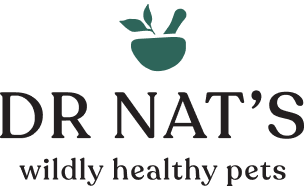Ever wondered how your pet could develop natural immunity to the paralysis tick toxin? Or why so many pets seem vulnerable to parasites and chronic disease today? Holistic vet Dr Nat shares her insights. In fact, both her childhood cat and her family dog developed natural tick resistance—something that’s surprisingly achievable.
Preventing parasites and disease has become a top concern for pet owners—and a major money maker for pharmaceutical companies. But how did animals stay healthy before we had all these chemical preventatives? The truth is, chemical treatments come with risks. So what’s the alternative?
Wild animals naturally develop immunity to the paralysis ticks, and interestingly, tick antiserum (used to treat tick paralysis) is produced using dogs that have already built resistance to the paralysis tick toxin1. The issues we are not addressing are that many modern pets are fed ultra-processed diets, overloaded with vaccines and environmental toxins. This can create gut imbalance, immune suppression, and toxicity. One example of this that has been well highlighted is the heavy metals found in pet food2.
Parasites are opportunists; they tend to thrive in weaker hosts. In livestock, it’s common for the weakest individuals to carry the heaviest parasite burden. Stressors have a large part to play in these immunity breakdowns. Worming too frequently or when it’s unnecessary is also likely to lead to more problems, such as resistance within the worm populations3. Thus, other management strategies other than reliance on chemicals are very important. Luckily, unlike a herd of livestock, your pet has the advantage of living under your care—with access to nourishing, species-appropriate food and natural support.
With a little education and guidance, you can help your pet build robust immunity, resilient gut health, and natural resistance to parasites—reducing their reliance on chemicals and setting them up for a long, healthy life.
Why Consider Natural Parasite Prevention?
- Adverse reactions: Parasite preventatives can sometimes cause adverse reactions ranging from contact dermatitis4 to neurologic adverse events such as tremors, ataxia and seizures5. Occasionally, these are lifelong, affecting long-term health.
- Reduce chemical load: More frequent chemical treatments mean more load and strain on the liver and increased probability of disrupting gut flora6. For example, one study showed mebendazole (a common chemical dewormer) reported cases of vomiting, jaundice, hemorrhagic diarrhea, and even liver failure leading to death7.
- Gut–Immune Connection: A strong immune system—rooted in a balanced gut—can help naturally repel parasites and reduce reactions to bites8.
- Fewer Side Effects: Natural options are often gentler, with fewer risks like vomiting, seizures, or organ strain9.
- Sustainability: Many synthetic chemicals used in parasite treatments can leach into waterways or harm wildlife10.
- Tick Toxin Resilience: Pets with strong immune systems may be less affected by the tick paralysis toxin and may even build tolerance over time11.
Step 1: Daily Tick Checks (Non-Negotiable)
Whatever method you choose, daily tick checks are essential. For natural resistance to form, your pet may need small, controlled exposure to the tick toxin—but the key is early removal. Especially in the beginning, ticks must be found and removed quickly.
Check:
- Behind ears, under collars
- Armpits, groin, between toes
- Face, lips, chin, and tail base
Fun fact: Around 90% of ticks are found in front of the shoulders, especially on the neck and head.
It’s important to familiarise yourself with the signs of tick paralysis:
- Wobbly gait or weakness, especially in the back legs
- Vomiting (often yellow froth)
- Difficulty breathing or changes in bark
If you notice any of these symptoms, seek veterinary care immediately.
Step 2: Holistic Support with Natural Remedies
Support your pet’s internal defences using gentle, plant-based remedies that help repel parasites and build resilience:
- Defend Immune Tonic – Strengthens gut flora and immune balance to make your pet less attractive to parasites. One of the main ingredients, along with 5 other herbs, is garlic. Garlic has been shown to contain bioactive compounds with anti-parasitic effects12. It also contains pre and probiotics to support robust gut health.
- Shield Skin & Coat Spray – A pre- and probiotic topical with a number of herbs and essential oils, such as neem to support skin health and help deter pests naturally.
- Restore Digestion Tonic – Supports gut health and detox pathways with wild-fermented ingredients like pineapple, which has anti-parasitic effects13. This also contains pre and probiotics supporting healthy gut flora.
- Tick Drops* (Homeopathic) – May support the body’s ability to form natural immunity to the paralysis tick toxin. Safe for long-term use.
- Food-grade Diatomaceous Earth – can be used internally for 7 days around the full moon to help manage internal parasites.
*While most of these products can be found on Dr Nat’s website you will need to contact her directly if you are interested in the Tick Drops.
Step 3: Nutrition Matters
A raw or gently cooked, species-appropriate diet strengthens immune function, improves skin health, and reduces inflammation14—making your pet a less suitable host for parasites. Avoid dry kibble and processed food wherever possible.
🔍 Want guidance on raw feeding? Read this article or book a consult with Dr Nat for tailored advice.
Step 4: Testing and Monitoring
Even with natural prevention, regular testing ensures you’re on the right track.
- Fecal test for worm eggs – Every 6 months
- Heartworm blood tests – Every 6 months in Queensland (or annually in lower-risk areas and if mosquito exposure is minimal)
Have young kids in the house? Consider using a conventional wormer such as Milbemax every 3 months to protect human health.
Optional Step: Plant Border Herbs to Repel Pests Naturally
Creating a healthy environment for your pets doesn’t stop at what goes in their body—it extends to the space around them. By planting certain herbs in your garden or keeping them in pots around the yard, you can build a natural barrier against parasites. Many aromatic plants release compounds that insects dislike, discouraging fleas, ticks, and mosquitoes from settling where your pets play.
Best herbs to plant:
- Rosemary – repels fleas, ticks, and mosquitoes
- Mint – discourages fleas and ants (best kept in pots to contain spreading)
- Lavender – deters moths, fleas, and flies, while promoting calm
- Lemongrass & Citronella – powerful mosquito repellents
- Basil – wards off flies and mosquitoes
Practical Tip:
Use these herbs as living borders along fences and pathways, or keep them in pots near verandas, entryways, and dog runs. This creates a protective, chemical-free shield for your pets while beautifying your space with greenery and fragrance.
When to Use Conventional Tools
There’s a time and place for everything. If you’re travelling to a tick-dense area or during peak tick season, short-term chemical use may be necessary. If you live in a tick-prone area, you may consider the risk of tick paralysis so high that you have no choice but to use a chemical preventative. If so, choose lower-risk options like:
- Seresto collar
- Frontline spray or top spot
- Monthly Credelio is considered a safer option out of the newer tick preventatives in the isoxazoline class of drugs**.
- Valuheart (heartworm only, more affordable)
💡 After any chemical use, support your pet’s gut and liver with detox strategies. Book a consult with Dr Nat for guidance.
** Isoxazoline drugs have been associated with neurologic adverse reactions in dogs. This can range from tremors and ataxia to seizures. Seizures have been reported in dogs after receiving isoxazoline class drugs, even when there has been no previous history of seizures15.
The Bottom Line
Natural parasite prevention isn’t passive—it’s proactive. The goal is to build resilience and reduce reliance on chemicals over time.
✔️ Build gut and immune strength
✔️ Use natural repellents consistently
✔️ Test regularly
✔️ Minimise chemical use as much as possible
✨ Start with restoring gut health using Dr Nat’s Restore Digestion Tonic and Nourish Pet Tea.
⚠️ Important Disclaimer: Assess What’s Right for You and Your Pet
While natural parasite prevention and supporting your pet’s immunity are absolutely achievable, it’s not a one-size-fits-all solution. Always take into account your unique circumstances, including:
- Your location – Are you in a known high-risk tick area?
- Your lifestyle – How consistently can you perform thorough daily tick checks?
- Your pet’s coat – Is it thick or long, making ticks harder to find?
- Seasonal factors – A wet summer often leads to a heavier tick season come late winter and spring.
If you’re in a high-risk area or can’t check your pet reliably, using a tick collar such as the Seresto collar during peak tick seasons can offer an added layer of protection. Keep in mind, no method—natural or chemical—is 100% effective, and pets can still encounter ticks. However, building their natural immunity can still happen alongside conventional methods and will benefit them long term.
👉 Always consult a trusted holistic or integrative vet when deciding on the best approach for your pet.
Dr. Nat’s Disclaimer: This information is for educational purposes only. Please consult your veterinarian for specific questions about your pet. Consult’s are available with Dr. Nat here.
References
- NSW Department of Primary Industries. (n.d.). Guidelines for tick serum producers. Retrieved August 21, 2025,
- SPEX CertiPrep & CEM Corporation. (2019). Heavy metals in pet food: Changes in heavy metal contamination in pet food over the past decade. Spectroscopy Online.
- Local Land Services. (n.d.). Cattle parasite management. Retrieved August 21, 2025
- Gwaltney-Brant, S. M. (2024, March 29). Adverse reactions to spot-on flea and tick products. Veterinary Partner – VIN.
- Food and Drug Administration. (2023,]). Fact Sheet for Pet Owners and Veterinarians about potential adverse events associated with isoxazoline flea and tick products. U.S. Department of Health and Human Services.
- Swift, D. (2019, October 23). 18 Common Drugs Tied to Altered Gut Microbime. MedPage Today.
- D. Polzin, Stowe Cm, O’Leary Tp, J. Stevens, Robert M. Hardy
(1981). Acute hepatic necrosis associated with the administration of mebendazole to dogs. Journal of the American Veterinary Medical Association - Pilla, R., & Suchodolski, J. S. (2020). The role of the canine gut microbiome and metabolome in health and gastrointestinal disease. Frontiers in Veterinary Science, 6, 498.
- U.S. Food and Drug Administration. (2018, September 6). Fact sheet for pet owners and veterinarians about potential adverse events associated with isoxazoline flea and tick products.
- Department for Environment, Food & Rural Affairs. (2025, July 22). Government publishes plan to address presence of chemicals from pet flea and tick treatments in UK waterways. GOV.UK.
- Rodriguez-Valle, M., et al. (2021). Editorial: Ticks and host immunity. Frontiers in Immunology, 12, 796558.
- Dardona, Z., Amane, M., & Boussaa, S. (2024). Garlic (Allium sativum): An in-depth review focusing on its potent antiparasitic activity. GSC Biological and Pharmaceutical Sciences, 28(3), 007–026.
- Nanvare, K., Rajpure, S., & Mote, U. (2025). Anti-helminthic syrup by herbal extract. International Journal of Pharmaceutical Sciences, 3(6), 1358–1372
- University of Helsinki. (2020, November 13). Dry food or raw? Diet affects skin gene expression in both healthy and atopic dogs. ScienceDaily.
- Drugs.com. (n.d.). Credelio Quattro (lotilaner, moxidectin, praziquantel, and pyrantel chewable tablets). Drugs.com. Retrieved August 23, 2025





